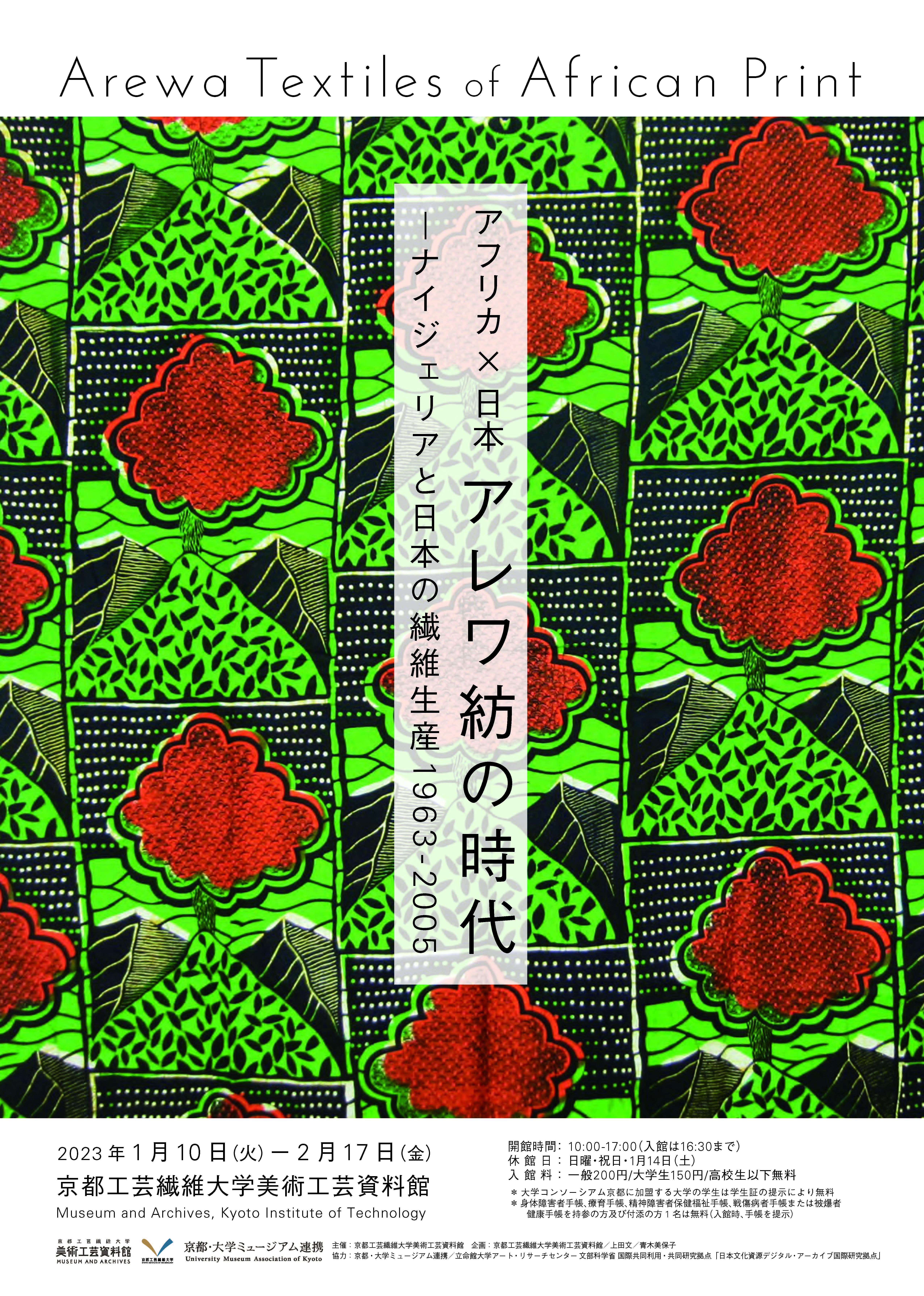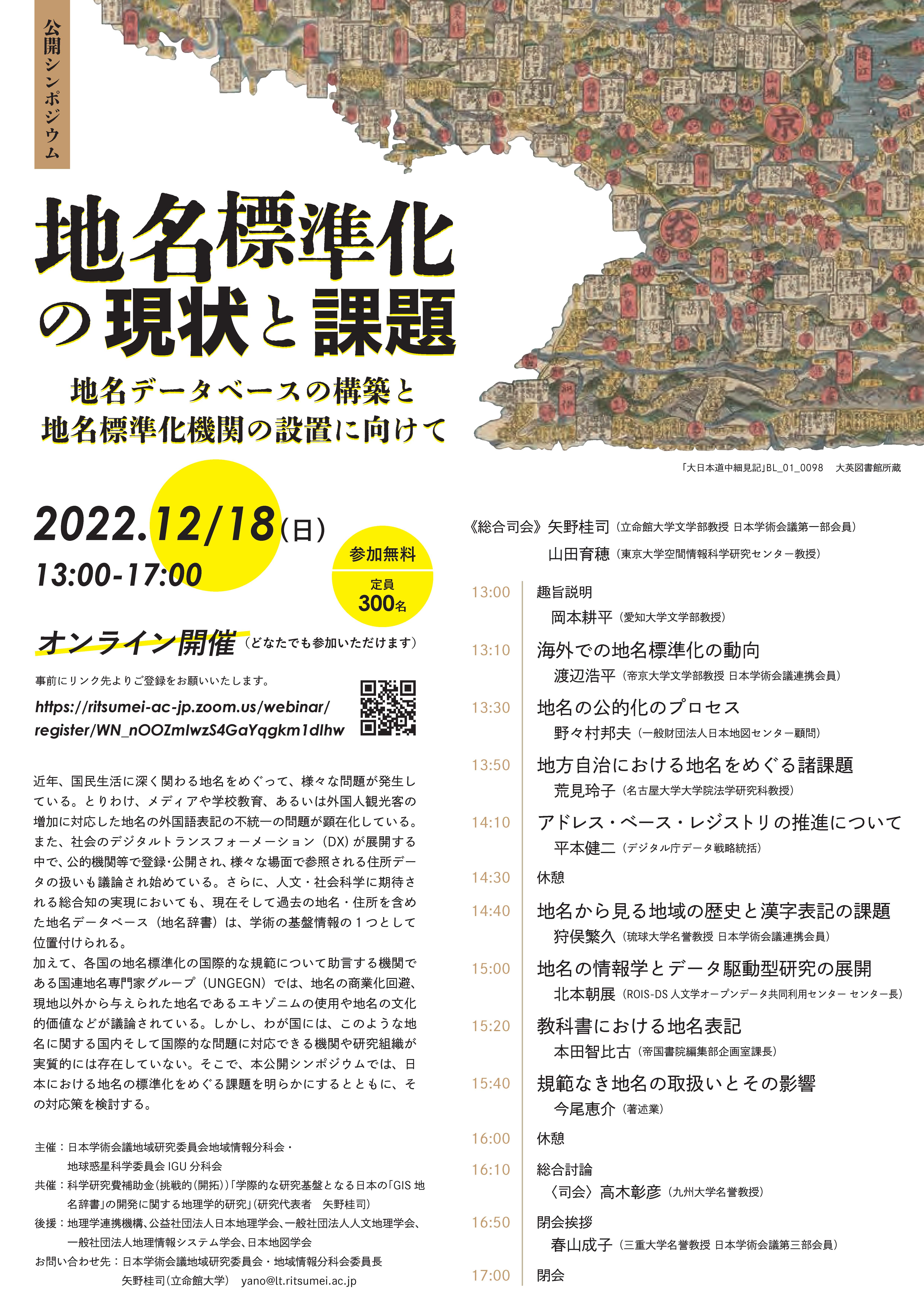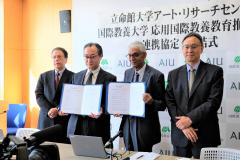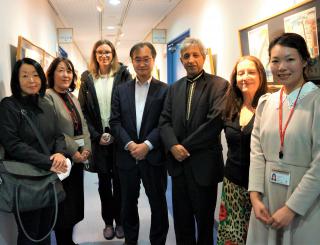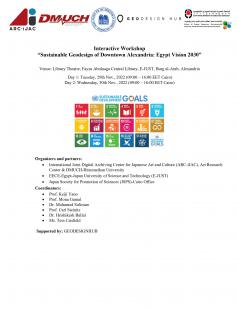-
 11
12
13
14
15
16
17
18
19
20
21
11
12
13
14
15
16
17
18
19
20
21
 [イベント情報]January 10, 2023(Tue)
[イベント情報]January 10, 2023(Tue)Supported by the International Joint Digital Archiving Center for Japanese Art and Culture (ARC-iJAC), the exbibition 'Arewa Textiles of African Print (「アフリカ×日本:アレワ紡の時代―ナイジェリアと日本の繊維生産 1963-2005」)' will be held at the Museum and Archives, Kyoto Institute of Technology from January 10, 2023.
Exhibition period: January 10 (Tues) - February 17 (Fri), 2023
Organizer: Museum and Archives, Kyoto Institute of Technology
Co-organizer: International joint research project 'A Digital Archive Connecting Modern Design and Industry: Towards a New History of Machine Textile Printing in Modern Kyoto' (「新しい近代京都機械捺染史構築に向けて―近代デザインと産業史をむすぶデジタル・アーカイブを一助として―」), adopted by the International Joint Digital Archiving Center for Japanese Art and Culture (ARC-iJAC)/ Project leader: Aya Ueda (Part-time Lecturer, Kwansei Gakuin University and Doshisha Women's College of Liberal Arts)
Supported by: University Mseum Association of Kyoto, International Joint Digital Archiving Center for Japanese Art and Culture (ARC-iJAC), Art Research Center, Ritsumeikan University
More information. ↓ ↓ ↓
[イベント情報]December 28, 2022(Wed)The 12th Forum for Knowledge, Arts, and Culture in Digital Humanities will be held online on Saturday, February 18, 2023. We are now calling for presenters to join this event.
■ Date: February 18 (Sat), 2023
■ Participation method: Hybrid (at Ritsumeikan University Osaka Ibaraki Campus & online via ZOOM)
Venue: Ritsumeikan University Osaka Ibaraki Campus
2-150 Iwakura-cho, Ibaraki, Osaka 567-8570, Japan*Depending on the situation of the spread of COVID-19, the event may be held entirely online.
■ Registration:
Please register via the URL below:
https://forms.gle/9LMBxercKFYkWw4v6
Registration deadline: December 28 (Wed), 2022.
■ Presentation time: 20 minutes including Q&A (to be adjusted according to the number of presenters).
(Presentation time and instructions for submitting presentation materials will be sent to the presenters after the deadline.)
Participation is free of charge.
■ Research fields:
1. Research in the arts and culture and other fields using information technology
2. Research in information technology that can be applied to arts, culture, and other fields
■ Samples of research presentation content:
1. Structural analysis, modeling, visualization, and knowledge discovery of information and knowledge in the arts and other fields
2. Representation, production, organization, database construction, search and provision of information and knowledge in the arts and other fields
3. E-publishing, digital libraries, digital museums and art galleries
4. Terminology in the arts and other fields, thesaurus
5. Information and knowledge distribution and intellectual property rights in the arts and other fields
6. Open data, data publishing, linked data
7. The internet, semantic web, web x.0, etc.
8. Other research and developments related to information and knowledge for culture at large
Organizer: The Forum for Knowledge, Arts, and Culture in Digital Humanities
Facilitators: Ryo Akama (Ritsumeikan University), Mamiko Sakata (Doshisha University), Naoki Takubo (Kindai University), Takehiko Murakawa (Wakayama University)
Co-organizers: The Kansai Division of the Art Documentation Society and the Kansai Division of the Japan Society of Information and Knowledge
In cooperation with: International Joint Digital Archiving Center for Japanese Art and Culture (ARC-iJAC), Art Research Center, Ritsumeikan University.
Inquiries: kacimeeting+2023■gmail.com (please change "■" to "@")
About the Forum for Knowledge, Arts, and Culture in Digital Humanities
Along with the rapid development of the digital and information environment in recent years, we are seeing more and more cross-disciplinary research in academic fields with an awareness of "information" and "digital". This trend is gaining momentum in higher education and research activities as well, and educational programs and course activities related to this trend are being enhanced.
The need for opportunities for academic exchange among undergraduate and graduate students and young researchers studying in such programs under new research themes in line with the times is ever increasing.
For this reason, the Forum for Knowledge, Arts, and Culture in Digital Humanities was established in 2011 as a place for presentation and exchange, with a focus on graduate students and young researchers interested in information and knowledge research in arts, culture, and other related fields in mind. 11 research meetings have been held to date.
This meeting is positioned as a place where participants can mutually discover new research themes and methods through human exchange in different fields, and we also welcome exploratory and adventurous presentations that are slightly different from conventional conference presentations.
■ Related links:
[イベント情報]December 26, 2022(Mon)The application for FY 2023 International Joint Research with Research Fund is open until January 20 (Fri), 2023, 5PM (JST). Successful projects will receive research funds from the ARC-iJAC.
Learn more about the application here.
Read more>>[イベント情報]December 21, 2022(Wed)The 113th International ARC Seminar will be held as a Webinar on Wednesday, December 21, from 18:00 JST.
The program is as follows:
1. Session
Speakers: Midori Ogita (Lecturer, Humanities Division, NIT(KOSEN), Maizuru College)
Topic:'Classroom Practice in NIT(KOSEN) Colleges for the Integration of Classics and Science: Using the Kuzushi-ji Reprinting Learning and Support System'
2. Session
Speaker: ZHANG Yutao (Ph.D. Candidate, Graduate School of Information Science and Engineering, Ritsumeikan University)
Topic: 'A Study on Speech Recognition System for Kuzushiji Transcription'
Date: Wednesday, December 21, 18:00 - 19:30 JST
Participation: online via Zoom, free of charge (no reservation required)
*This Webinar is open to everyone, and non-ARC members are also invited to participate via YouTube.
[イベント情報]December 18, 2022(Sun)Professor Keiji Yano, Deputy Director of the Art Research Center (ARC), Ritsumeikan University, will serve as chair for the public symposium 'Current Status and Issues of Place Name Standardization: Toward the Establishment of a Place Name Database and a Place Name Standardization Organization', organized by the Science Council of Japan.
Date: December 18 (Sun), 2022, 13:00-17:00 JST
Participation: Online
Anyone is welcome to attend (registration required).[イベント情報]December 13, 2022(Tue)The Art Research Center (ARC), Ritsumeikan University, is pleased to announce the conclusion of a Memorandum of Understanding (MoU) with Akita International University (AIU), a leading institution in international liberal arts education in Japan.
On November 28, 2022, a signing ceremony for the MoU was held at Akita International University and attended by Professor Ryo Akama (College of Letters), Director of the ARC, and Professor Koichi Hosoi (College of Image Arts and Sciences), Deputy Director of the ARC.
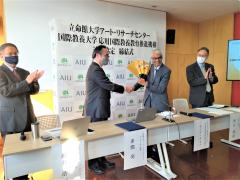
Akita International University was represented by Professor Monte Cassim, President of AIU, and Professor Yoshitaka Kumagai, Vice President of AIU. As former President of Ritsumeikan Asia Pacific University (APU) and former Vice-Chancellor of the Ritsumeikan Trust, Professor Cassim has been pivotal in bringing about this partnership.
The MoU provides a stable framework to advance collaborative projects in digital humanities, in particular, with regards to the building of a digital archive database of materials related to traditional art and culture of the Tohoku region by integrating AIU's Akita Folkloric Performance Art Archives in the ARC Portal Database System--hence, facilitating the dissemination of such materials worldwide.
The Akita Folkloric Performance Art Archives comprise audiovisual records of more than 300 folkloric performance arts in Akita Prefecture held by AIU.
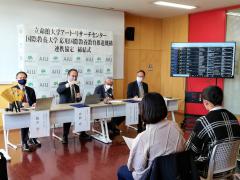
In addition, the MoU shall strengthen academic research on both sides through the organization and participation in joint research programs and events as well as the exchange of researchers from both institutions.
Following the signing ceremony, a round-table discussion was held, where Professor Kumagai introduced the Akita Folkloric Performance Art Archives and Professor Akama explained how the integration of the archives into the ARC Portal Database System worked. Furthermore, both parties shared their thoughts on preserving Japanese cultural heritage.
Official website of Akita International University (AIU): https://www.aiu.ac.jp
The Akita Folkloric Performance Art Archives: https://www.akita-minzoku-geino.jp/archives/
Art Research Center (ARC) databases: https://www.arc.ritsumei.ac.jp/e/database/
[イベント情報]December 8, 2022(Thu)On November 21 (Mon), 2022, Professor Adam Habib, the Director of the School of Oriental and African Studies (SOAS), University of London, visited Ritsumeikan University to meet with Professor Yoshio Nakatani, President of Ritsumeikan University. SOAS is a world-leading institution for the study of Asia, Africa, and the Middle East.
Accompanied by Professor Nana Sato-Rossberg, Chair of the SOAS Centre of Translation Studies and an alumna of Ritsumeikan University's Graduate School of Core Ethics and Frontier Sciences, and Kanina Foss, Chief of Staff, Professor Habib visited the Art Research Center (ARC) as part of this trip where he met with Professor Ryo Akama, Director of the ARC.
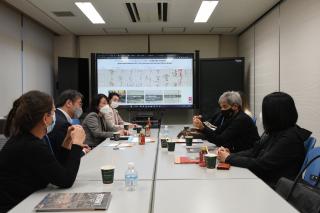
After Professor Akama introduced the international joint research projects of the ARC in digital humanities, including digital archiving projects in collaboration with the British Museum (BM) and faculty members of SOAS, the two of them discussed the possibility of establishing a partnership in digital humanities with a focus on digital archiving the Japanese collection held by SOAS.
Furthermore, Professor Habib was keen on exploring opportunities for future collaboration in video game research, in particular, gaming with a social justice element.
During the meeting at the ARC, Professor Habib praised the center's efforts in digital humanities research and in serving as an international hub for joint research in the digital archiving of Japanese art and culture as he expressed the aspiration of SOAS to serve as a bridge for different, transnational knowledge systems.
[イベント情報]December 7, 2022(Wed)The 111th International ARC Seminar will be held as a Webinar on Wednesday, December 7, from 18:00 JST.
The program is as follows:
1. Session
Speakers: Fadjar I. Thufail, Ph.D. (Director, Research Center for Area Studies (PRW), National Research and Innovation Agency (BRIN))
Upik Sarjiati, MPP (Researcher, Research Center for Area Studies (PRW) National Research and Innovation Agency (BRIN))
Topic: 'Assembling Borobudur as a World Heritage: An Actor-Network Approach'
2. Session
Speaker: Bramantara, ST. MA. (Borobudur Conservation Office)
Topic: 'Reshaping the Past: The Use of 3D Technology for the Preservation of Cultural Heritage in Indonesia'
Date: Wednesday, December 7, 18:00 - 19:30 JST
Participation: online via Zoom, free of charge (no reservation required)
[イベント情報]November 29, 2022(Tue)The interactive workshop 'Sustainable Geodesign of Downtown Alexandria: Egypt Vision 2030' will be co-organized by the International Joint Digital Archiving Center for Japanese Art and Culture (ARC-iJAC), Art Research Center, Ritsumeikan University.
Venue: Library Theatre, Fayza Abulnaga Central Library, E-JUST, Burg al-Arab, Alexandria
Day 1: Tuesday, 29th Nov., 2022 (09:00 - 16:00 EET Cairo / 16:00 - 23:00 JST)
Day 2: Wednesday, 30th Nov., 2022 (09:00 - 16:00 EET Cairo / 16:00 - 23:00 JST)For inquiries, please contact: r-darc@st.ritsumei.ac.jp.
Click here for the agenda. ⇊
[イベント情報]November 14, 2022(Mon)The International Joint Digital Archiving Center for Japanese Art and Culture (ARC-iJAC), Art Research Center, Ritsumeikan University, presents:
Training Course to Decipher Japanese Cursive Script (Kuzushiji) with the ARC Transcription Support and Archiving System
<Tutor guidance provided>
We are pleased to announce that the Training Course for the ARC Transcription Support and Archiving System for Japanese Cursive Script (kuzushiji) with tutor guidance, which was well received last year, will be resumed.
This training course will be conducted online using the ARC databases of early Japanese books, ukiyo-e and old documents, as well as the ARC Kuzushiji Transcription Support and Archiving System, allowing participants to practice reading kuzushiji anytime, anywhere, and at their own pace. Features include an AI-enabled function to read kuzushiji and online guidance provided by experienced tutors.
Unlike one-off courses, you can advance your transcription skills as you read through the books and materials independently.
We welcome applications from beginners and intermediate-level participants, as well as those who wish to improve specific transcription projects.
Participation is free of charge.
This training course is supported by the Consortium for Global Japanese Studies.
If you would like to participate, please apply using the form below.
↓↓↓
Application formApplication is closedDeadline: November 22 (Tues), 2022, 12:00 JST
[Details of the Training Course]
Period: December 1, 2022, to March 15, 2023
Language of Instruction: Japanese
Target:
1. Beginners to intermediate level users who would like to transcribe documents written in kuzushiji (capacity: 25 people)
2. Individuals and groups who would like to improve their own projects using the ARC Kuzushiji Transcription Support and Archiving System (individual correction is not provided, but consultation for difficult-to-read characters is available. Capacity: 5 people)
[Schedule]
11/25 Notice of acceptance (tentative)
11/30 Kick-off seminar at 20:00 Japan Standard Time (online/ video on demand available)
- Keynote speaker: Motoi KATSUMATA (Associate Professor, Meisei University, Tokyo)
- Explanation of the course outline and system, introduction of tutors, etc.
12/4 1st System training session (online)
- Session A (from 9:00 JST), Session B (from 20:00 JST)
* We plan to hold several system training sessions during this period.
The closing meeting will be held in late March 2023.
Inquiries:
Office of the International Joint Digital Archiving Center for Japanese Art and Culture (ARC-iJAC)
Art Research Center (ARC), Ritsumeikan University
Contact persons: Sekiguchi, Emily, Kubo
E-mail: r-darc@st.ritsumei.ac.jp
Tel.: +81 75-465-8476 (ext. 2825)
 11
12
13
14
15
16
17
18
19
20
21
11
12
13
14
15
16
17
18
19
20
21



